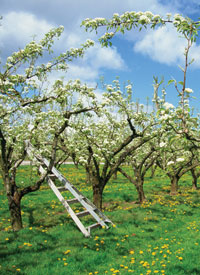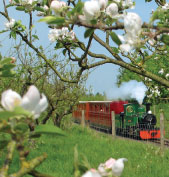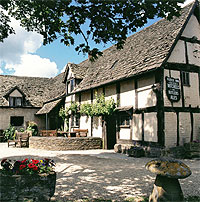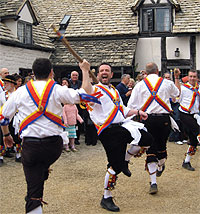We reveal the hidden gems of Worcestershire’s Blossom Trail in the Vale of Evesham and discover an area rich in historic houses, glorious gardens and fine British fare.
 |
| Pear blossom in full bloom at Holt Fleet orchard in Worcestershire |
You know that people take their horticulture seriously when they name a steam train after a local plum, decorate world-famous porcelain with local fruits, and celebrity resident, designer Stella McCartney, asks her wedding guests to donate trees so she can plant a small wood. And would you pay £1,200 at auction for 120 spears of asparagus?
Venture to the Vale of Evesham in southern Worcestershire – where all this happens – a place of quirky rural charm. Sheltered by the Cotswold, Bredon and Malvern Hills, it stretches along the valley of the River Avon below Stratford-upon-Avon, through Evesham and into Pershore. Since medieval times the area has been renowned for fruit growing and it remains one of England’s most prolific market gardening centres.
Blossom time, mid-March to mid-May, is especially enchanting, as 3,000 acres of orchards burst into colour: scented cascades of white plum and damson flower, followed by white pear and pink apple. You can see some of the prettiest sights by driving along the 45-mile Blossom Trail, while The Vale Trail covers similar ground from a general horticultural and gastronomic angle.
Evesham is right at the heart of the Vale and chief among its attractions is The Almonry Heritage Centre. Once the medieval home of the abbey’s almoner who doled out aid to the poor, it now houses collections that give fascinating insights into the town’s past. Visitors often bump into a monk – in reality the centre’s manager Tony Whiting – who explains how Eof, an 8th-century swineherd, saw a vision that led to the foundation of Evesham Abbey, around which the town grew. The abbey became one of the wealthiest in the land until King Henry VIII, having broken away from the Catholic Church, suppressed it in 1539 – the impressive Bell Tower is the only major building to remain.
 |
| Evesham Vale Light Railway |
The Almonry also tells the tale of the Battle of Evesham, 1265, a decisive encounter in the Barons’ War against King Henry III. The barons, led by ‘father of the English Parliament’ Simon de Montfort, sought government reform.
But the royal army defeated them, killed de Montfort and buried his mutilated body in a secret location. “Pilgrims flocked to Evesham and treated de Montfort like a saint,” Tony says. “If he’d won, we might have had democratic parliament before we did!”
Other highlights at The Almonry are the intriguing Anglo-Saxon grave goods, among them a red amber and quartz necklace. “Amber was traded in northern Europe for English fruit,” Tony reveals, adding, “They must have had some advanced knowledge of refrigeration.”
The Vale’s second market town of note is Pershore, along the River Avon to the west of Evesham. Its beautiful Norman Abbey, Georgian architecture and stories of English Civil War skirmishes offer plenty to keep historians happy.
But the greatest reason for the town’s fame is more offbeat – plums. Three juicy types carry its name, including the Pershore Yellow Egg that was discovered growing wild in nearby Tiddesley Wood in 1827. By 1870, over 900 tons of the fruit were being sent to market. To celebrate the centenary of the fi nding of the Yellow Egg, a steam train was even called Pershore Plum. Every August Bank Holiday Pershore Plum Fayre confi rms the town’s fruitful reputation with plum tastings (including Plum Ale), exhibitions and a farmers’ market.
 |
| The 17th-century Fleece Inn |
The Vale is full of fine plant centres and there’s one at Pershore College, the Royal Horticultural Society’s centre for the West Midlands. Here, too, is a thriving apple juice and cider processing setup that uses fruit grown at the college and by local farmers. Each year the college makes around 20,000 litres of own-label apple juice and 45,000 on behalf of others – classic apple, apple mixed with blackcurrant, or spiced with ginger or cinnamon. Cider is matured in oak rum or whisky barrels.
Farther west again, neighbouring the Vale, there’s more retail temptation at the Worcester Porcelain Museum. Here you can see exquisite pieces of Royal Worcester porcelain, which used to be manufactured on this site and are still for sale in the adjacent shop. Founded in 1751, the company held royal warrants from every monarch since George III.
The museum contains many fascinating exhibits, not least George III’s 1807 tea service featuring saucers with solid gold undersides to show off – he always tipped the royal tea into his saucer to slurp rather than use a cup.
Also skirting the Vale are two wonderful garden treats. Spetchley Park has been in the Berkeley family for over 400 years and embraces 30 acres of themed gardens and rare plants. Worcestershire-born composer Sir Edward Elgar stayed here many times, living in Gardener’s Cottage. He was inspired by the sound of the wind in Spetchley’s pine trees to begin his choral masterpiece, The Dream of Gerontius.
 |
| Morris dancing at the annual Asparagus Festival |
The second treat is National Trust-owned Hanbury Hall, a typical William and Mary House built in warm red brick, with impressive murals by Thornhill. The garden is a spectacular recreation of early 18thcentury formal plans, one highlight of which is the sunken parterre garden. Head gardener Neil Cook reveals his team plants 4,800 bulbs in the ribbon border each year and it takes three gardeners five weeks, working two-and-a-half days per week, to trim the 4,206 box bushes.
Vale villages are as varied as they are full of eccentric character, with cottages of red brick, black-and-white timber, and honey-coloured stone. The five Lenches to the north are prettily interwoven with orchards, and Offenham, erstwhile scene of the massacre of Simon de Montfort’s troops, is one of only five villages in the country with a maypole.
Even quirkier, Wick is home to The Real Flower Petal Confetti Company, which makes natural, biodegradable confetti from its 10-acre delphinium field – it reaches full glory in July. The confetti is popular at royal and celebrity weddings, and each year the field is planted in a different design: the Delphinium Union Jack made it into The Guinness Book of Records as the world’s largest carpet of flowers.
A favourite village for many people, though, is Bretforton, built almost entirely in the 17th century. Here, the medieval Fleece Inn is everything you expect of an old English pub, with cosy nooks and a huge fireplace. The pub hosts annual asparagus auctions during The British Asparagus Festival (23 April-21 June).
“Two years ago I was bidding for a ‘hundred of asparagus’ – actually 120 spears – that raised a record £1,200,” landlord Nigel Smith says. “Luckily a local fruit and vegetable wholesaler outbid me, otherwise it would have been a very expensive lunch.”
And Worcestershire’s most beautiful village? Broadway often gets the vote thanks to its melted-gold buildings and it’s just the place to take a leisurely afternoon tea. Then wander the Vale’s southern highpoints: Broadway Tower above Broadway is an 18th-century Gothic folly that gives amazing views across the landscape. Bredon Hill, by contrast, inspired A E Housman’s poem of the same name, and from the 991ft summit there are breathtaking vistas over the River Avon. A highpoint indeed.
Find out more about the county of Worcestershire
Veiled delights
- Asparabus Tours and Blossom Trail Coach Tours, Dudleys Coaches: sit back and enjoy guided tours to all the seasonal hotspots for blossom (April) and asparagus (May). Tel: (01386) 792206.
- Eckington Manor Cookery Schools: a region so in love with local produce has to have a cookery school. Enjoy an activity break at Eckington – themed courses include Summer Desserts – and stay in the 700-year-old timberframed
hall house. Tel:
(01386) 751600.
- Handsam Boat Company, Evesham: river trips and boat hire from Abbey Park, taking in sights like the unusual rope ferry at Hampton.
Tel: (07860) 895416.
- Revills Farm Shop, Defford near Pershore: ideal for stocking up on local produce and specialist foods, and lunch or afternoon tea in the Old Stable Tea Rooms.
Tel: (01386) 750466.
- Worcester Porcelain Museum: a collection that dates from 1751 to the present day. Visit the adjacent retail outlet to buy your own piece.
Tel: (01905) 21247.
For further
information
- Tourist Information
Centres: Evesham:
Abbey Gate WR11
4BG, tel: (01386)
446944.
- Pershore: Pershore
Town Hall, 34 High
Street WR10 1DS,
tel: (01386) 556591.
- Worcester: The Guildhall, High Street WR1 2EY, tel: (01905)
726311.
If calling Britain from
overseas, dial your international code, then ’44’, and drop the first ‘0’ of the number.






 © 2024
© 2024